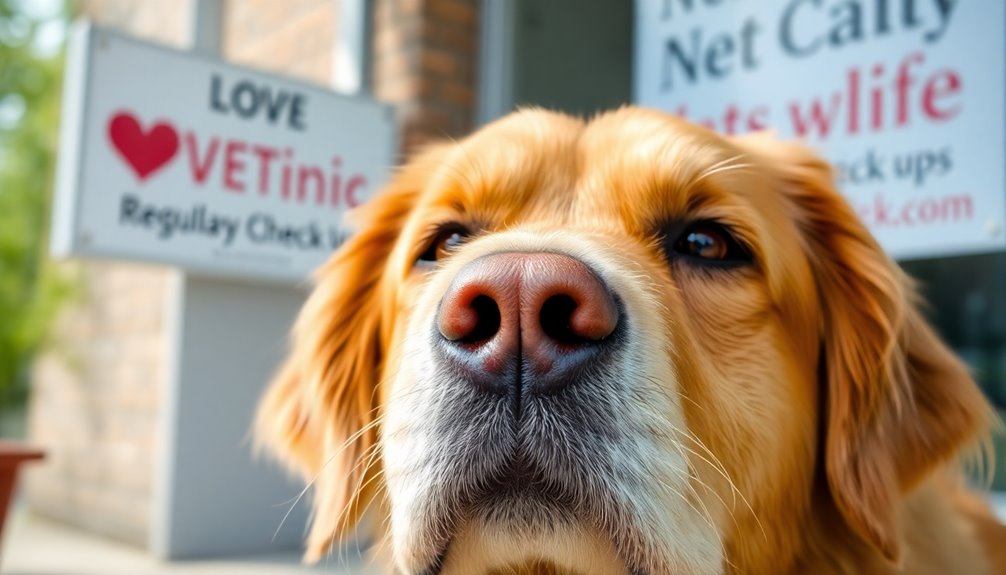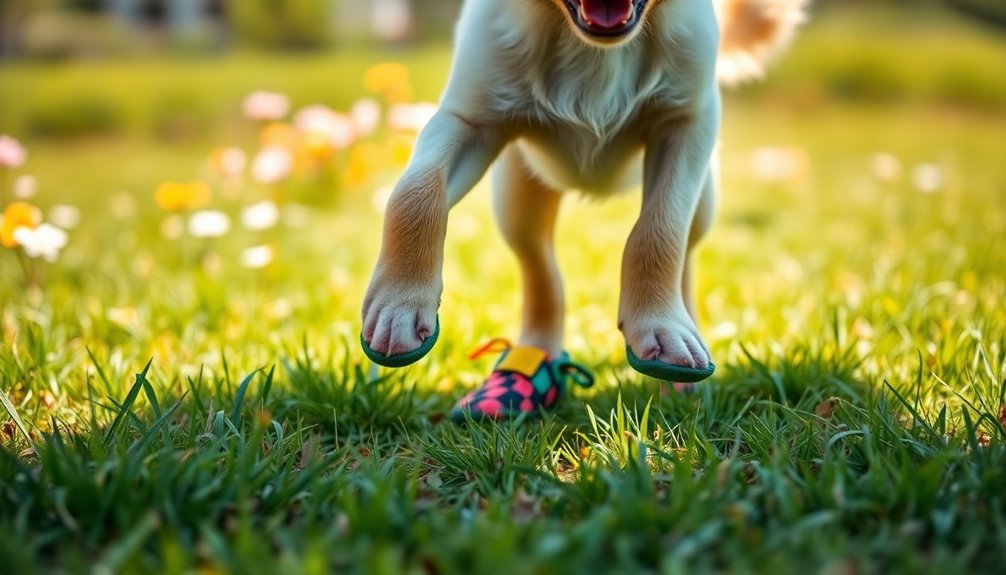To spot the first signs of aging in your dog, watch for changes in behavior and physical health. Notice if they show mobility issues, struggle to get up, or seem less active. Look for cloudy eyes or changes in their vision and hearing, like bumping into objects. Behavioral shifts, such as increased irritability or anxiety, can also signal aging. Pay attention to dental health; bad breath or swollen gums indicate potential problems. Regular veterinary check-ups are essential for early detection and management of these signs. There's much more to explore about keeping your aging dog comfortable and healthy.
Key Takeaways
- Monitor for mobility issues, such as difficulty getting up or reluctance to climb stairs, which may indicate joint problems or arthritis.
- Watch for behavioral changes, including increased grumpiness, anxiety, or confusion, which could signal underlying pain or cognitive dysfunction.
- Look for signs of vision loss, like bumping into objects or hesitance to navigate familiar spaces, often associated with aging eyes.
- Observe changes in dental health, such as bad breath or swollen gums, as dental disease is common in aging dogs and can affect overall health.
- Regular veterinary check-ups are essential for early detection of age-related health issues like arthritis, dental disease, and cognitive decline.
Physical Signs of Aging

As your dog ages, you might notice several physical signs that signal it's important to take a closer look at their health. One of the first things to watch for is cloudy eyes, which can indicate cataracts or other eye diseases that may affect their vision.
You might also see mobility issues; if your dog struggles to jump, climb stairs, or gets up slowly, it could be a sign of arthritis or degenerative diseases.
Keep an eye on weight changes too. Weight gain may occur if your dog becomes less active, while sudden weight loss could point to underlying health concerns.
Another important sign is bad breath, which often indicates oral health problems like gum disease or tooth decay. If you notice a significant change in their breath, it's wise to schedule a veterinary evaluation.
Lastly, be vigilant for any new lumps or bumps under their skin. While some may be benign, others could indicate more serious issues, so it's crucial to have them checked by a vet.
Staying alert to these signs will help guarantee your furry friend stays healthy and happy as they age.
Behavioral Changes to Watch

Behavioral changes in aging dogs can be subtle yet significant indicators of their overall health. You might notice sudden changes in your dog's demeanor, like increased grumpiness or irritability. These behavior changes could signal underlying pain or discomfort that requires your attention.
Additionally, some senior dogs develop Cognitive Dysfunction Syndrome (CDS), affecting 14%-35% of dogs over eight years old. Symptoms of CDS include confusion, disorientation, and forgetfulness of commands.
Pay attention to increased vocalization, such as barking or whining; this may indicate distress or discomfort. If you notice this, it's wise to consult your veterinarian for evaluation. Heightened anxiety can also emerge, leading to clinginess or destructive behaviors as your dog may develop fears of familiar objects or situations.
Moreover, changes in sleep patterns, like increased restlessness or pacing at night, might point to cognitive decline or discomfort. Keeping an eye on these behavioral changes can help you better understand your aging dog's needs and guarantee they receive the proper care and support during their golden years.
Vision and Hearing Loss

As your dog ages, you might notice signs of vision loss, like bumping into furniture or a foggy appearance in their eyes.
Hearing loss can also become apparent, with your pup seeming startled by loud noises or not responding to commands.
Recognizing these changes early can help you make adjustments to enhance their comfort and safety.
Common Signs of Vision Loss
Vision loss in dogs often manifests through several telltale signs that can be alarming for pet owners. As your dog ages, you might notice them bumping into objects or hesitating to navigate familiar spaces. They may also show discomfort in bright light, indicating potential vision issues. Aging in dogs can lead to conditions like cataracts, resulting in cloudy eyes and impaired vision.
Here's a quick overview of common signs of vision loss:
| Sign of Vision Loss | Description |
|---|---|
| Bumping into Objects | Frequently colliding with furniture or walls. |
| Hesitance to Navigate | Reluctance to move in familiar environments. |
| Discomfort in Bright Light | Avoids areas with strong lighting or sunlight. |
| Cloudy Eyes | Noticeable cloudiness, often due to cataracts. |
| Changes in Behavior | Increased anxiety or confusion, possibly linked to cognitive dysfunction syndrome. |
Regular veterinary check-ups are essential for early detection and management of these issues. Addressing signs of aging, including vision loss, can greatly improve your dog's quality of life, ensuring they remain happy and healthy.
Hearing Loss Indicators
Hearing loss in dogs can be subtle at first, making it easy to overlook. As your dog ages, you might notice certain signs indicating they're struggling with hearing loss. For instance, older dogs may startle easily at sudden noises or show reduced responsiveness when you call them or use commands. This lack of reaction can signal that they aren't hearing as well as they used to.
Another indicator is changes during playtime. If your dog seems less engaged or doesn't respond to familiar sounds, they might be experiencing hearing impairment. Excessive or inappropriate barking can also be a sign of confusion or an attempt to communicate when they can't hear themselves well.
It's important to note that studies reveal nearly 30% of dogs over eight years old suffer from some degree of hearing loss. Regular veterinary check-ups can help identify these issues early, allowing you to implement strategies to enhance communication with your aging dog.
Mobility and Joint Issues

Noticing changes in your dog's mobility can be alarming, especially if they struggle to get up, climb stairs, or jump like they used to. These mobility issues often signal joint pain or conditions like arthritis, which are common in senior dogs. You might observe that your pup is less enthusiastic to engage in physical activities, shows decreased stamina, or appears stiff after rest.
To help you identify mobility concerns, here's a simple table:
| Signs of Mobility Issues | What to Watch For |
|---|---|
| Difficulty getting up | Struggles to rise from lying down |
| Reluctance to climb stairs | Hesitation or refusal to ascend |
| Decreased activity level | Less playtime or walks |
| Visible stiffness | Limping or slow movement |
| Weight changes | Unexplained gain or loss |
Regular veterinary check-ups are essential for early detection and management of joint problems, as up to 25% of older dogs may develop osteoarthritis. Implementing gentle, low-impact exercises like short walks or swimming can help maintain your dog's mobility and joint health, keeping them active and comfortable in their golden years.
Dental Health Concerns

As your dog ages, dental health becomes increasingly important.
Bad breath can be a warning sign of gum disease or tooth decay, so keep an eye out for any changes.
Regular check-ups and proper dental care can help prevent serious issues and keep your furry friend happy and healthy.
Bad Breath Indicators
Bad breath in dogs, medically referred to as halitosis, can be a significant red flag for dental health issues, especially in aging pets. If you notice your dog's breath suddenly turning foul, it often signifies the need for a veterinary evaluation. This change could indicate underlying problems such as gum disease, tooth decay, or oral infections, which are more prevalent in older dogs.
Regular dental check-ups are essential for senior dogs, given that around 80% show signs of dental disease by age three. Poor dental health not only affects your dog's mouth but can also lead to systemic infections impacting critical organs like the heart and kidneys.
Maintaining good oral hygiene is important for your dog's overall health. If you observe any signs accompanying bad breath—such as difficulty eating, swollen gums, or excessive drooling—don't hesitate to consult your veterinarian.
Early intervention can prevent further complications and guarantee your furry friend remains healthy and happy as they age. Keep a close eye on their dental health to catch any issues before they escalate.
Gum Disease Symptoms
Gum disease in dogs can manifest through several alarming symptoms that every pet owner should watch for. One of the first signs you might notice is halitosis, or bad breath, which could indicate infection or decay in your dog's mouth. You should also be alert for swollen or bleeding gums, especially while eating or if you touch the mouth, as this signals periodontal disease that needs immediate veterinary attention. Increased drooling or difficulty chewing hard food can indicate pain from gum disease.
Here's a quick reference table of common gum disease symptoms:
| Symptom | Description | Action Needed |
|---|---|---|
| Halitosis | Bad breath, often a sign of infection | Schedule a vet visit |
| Swollen/Bleeding Gums | Gums that bleed during eating or touching | Seek veterinary care |
| Increased Drooling | Excessive drooling when eating | Evaluate dental health |
| Difficulty Chewing | Trouble eating hard food due to pain | Consult a vet |
| Tartar Buildup | Visible plaque or tartar on teeth | Regular dental check-ups |
Regular dental check-ups are essential, as studies indicate that up to 80% of dogs show signs of dental disease by age three. Early intervention is key!
Routine Dental Care
Maintaining your dog's dental health is essential, especially as they age. Routine dental care can greatly impact their overall wellbeing. By age 3, up to 80% of dogs may experience periodontal disease, which can lead to serious health complications if neglected.
Bad breath in older dogs often signals underlying dental issues like gum disease or tooth decay, potentially allowing harmful bacteria to enter the bloodstream.
To keep your dog's oral health in check, schedule professional dental cleanings at least once a year. This helps prevent plaque and tartar buildup, which causes pain and discomfort.
Additionally, daily dental care at home, including brushing their teeth and providing dental chews, can significantly improve their oral health and lower the risk of dental disease.
Pay attention to any signs of dental distress, such as reluctance to eat, pawing at the mouth, or excessive drooling. These symptoms warrant an immediate veterinary evaluation.
Urinary Changes

As your dog ages, you might notice some urinary changes that warrant your attention. Increased urination frequency can be a red flag, signaling potential issues like kidney disease or urinary tract infections. If your dog seems to need to go out more often or has difficulty urinating, it's vital to seek veterinary advice, as these could indicate serious conditions such as bladder stones.
You may also observe urinary incontinence, especially in older female dogs. This can lead to accidents around the house, affecting both your dog's comfort and your living space. It's important to monitor these changes closely, as they can greatly impact your dog's quality of life. Medications or dietary adjustments may help manage incontinence and make your pup feel more at ease.
Don't ignore any changes in your dog's urination patterns, like increased urgency or frequent accidents. Addressing these issues early can lead to better health outcomes.
Keeping an eye on your dog's urinary habits is essential for ensuring their continued well-being as they age.
Importance of Veterinary Visits

Scheduling regular veterinary visits is vital for keeping your aging dog healthy. These veterinary check-ups are important for identifying the early signs of aging and any underlying health issues. As dogs age, they become more susceptible to conditions like arthritis and dental disease, and early detection can greatly improve their quality of life.
One major concern is cognitive dysfunction, which affects approximately 14%-35% of dogs over eight years old. Routine evaluations help monitor cognitive health, allowing for timely interventions. During these visits, your vet can also guide you on necessary adjustments in your dog's diet and exercise routines, promoting better overall health as they age. Additionally, similar to pet therapy benefits, regular interaction with animals can enhance your dog's emotional well-being during this stage of life.
Don't let concerns about costs or difficult decisions deter you from seeking veterinary care. Regular check-ups provide peace of mind and tailored care plans that cater to your dog's specific needs.
Enhancing Comfort for Seniors

Regular veterinary visits lay the groundwork for your dog's health, but enhancing their comfort at home is equally important as they age.
Start by adjusting your dog's diet to include senior-specific nutrition, which can help maintain a healthy weight and support their overall well-being. Providing orthopedic bedding is essential; it alleviates joint strain and improves sleep quality, which is critical for senior dogs experiencing increased stiffness.
Incorporate gentle low-impact exercises, like swimming or short walks, to help maintain mobility without straining their aging joints. A safe and accessible home environment is important, so consider using ramps and non-slip rugs to prevent accidents, especially if your dog has reduced coordination.
Additionally, engaging your senior dog in mentally stimulating activities, such as puzzle toys or scent work, can help maintain cognitive function and reduce anxiety related to aging. Executive function is vital in ensuring they can navigate their environment safely and comfortably.
These interactions provide mental engagement and can keep their minds sharp. By focusing on these aspects, you can greatly enhance your dog's comfort, ensuring they enjoy their golden years with you to the fullest.
Frequently Asked Questions
How Can You Tell When a Dog Is Aging?
You can tell when a dog is aging by observing changes in their behavior and physical appearance.
Look for cloudy eyes, weight fluctuations, and any mobility issues. If your dog seems less energetic or reluctant to play, that's a sign.
Pay attention to grooming habits, too; an unkempt coat may indicate they're struggling.
New lumps or bumps on their skin should also raise a red flag, prompting a visit to the vet.
At What Age Do Dogs Start Feeling Old?
As the saying goes, "time flies when you're having fun."
Dogs start feeling old at varying ages depending on their size. Small dogs often hit that milestone around 7-10 years, while medium-sized breeds usually feel it at 7. Large and giant breeds typically start showing signs of aging by 5-6 years.
You'll notice changes in energy levels, sensitivity to temperatures, and grooming habits, so keep a close eye on your furry friend as they age.
What Age Do Dogs Start Showing Their Age?
Dogs typically start showing their age around 5 to 7 years old, but it really depends on their size and breed.
Larger breeds usually age faster, while smaller ones mightn't show signs until they're 10 to 12.
You'll notice changes in energy levels, grooming habits, or even how they react to sounds.
It's essential to keep up with regular vet check-ups, as health issues can become more common as they enter their senior years.
What Is Considered Old Age for a Dog?
Did you know that small dogs are typically considered senior by age 7, while large breeds hit that mark as early as 5?
This means the definition of "old age" for dogs varies considerably based on their size. Understanding these distinctions helps you prepare for your dog's changing needs.
Regular vet visits become essential as your furry friend ages, ensuring you can address any health concerns early and adjust their care accordingly.
Conclusion
As your dog ages, spotting those first signs can feel like deciphering an ancient code! You don't want to miss a single clue, from subtle mobility shifts to changes in their sparkle-eyed gaze. Regular vet visits aren't just a luxury; they're essential for keeping your furry friend feeling like the vibrant pup they've always been. By enhancing their comfort and monitoring their health, you're not just extending their life; you're adding joy to every wag and woof!










